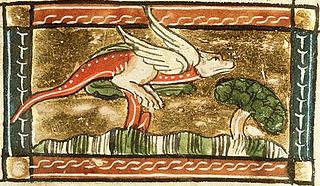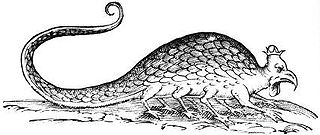The Aberdeen Bestiary is a 12th-century English illuminated manuscript bestiary that was first listed in 1542 in the inventory of the Old Royal Library at the Palace of Westminster.

The amphisbaena is a mythological, ant-eating serpent with a head at each end. The creature is alternatively called the amphisbaina, amphisbene, amphisboena, amphisbona, amphista, amfivena, amphivena, or anphivena, and is also known as the "Mother of Ants". Its name comes from the Greek words amphis, meaning "both ways", and bainein, meaning "to go". According to Greek mythology, the amphisbaena was spawned from the blood that dripped from the Gorgon Medusa's head as Perseus flew over the Libyan Desert with her in his hand, after which Cato's army then encountered it along with other serpents on the march. Amphisbaena fed off of the corpses left behind. The amphisbaena has been referred to by various poets such as Nicander, John Milton, Alexander Pope, Percy Bysshe Shelley, Alfred, Lord Tennyson, Aimé Césaire, A. E. Housman and Allen Mandelbaum; as a mythological and legendary creature, it has been referenced by Lucan, Pliny the Elder, Isidore of Seville, and Thomas Browne, the last of whom debunked its existence.

A bestiary, or bestiarum vocabulum, is a compendium of beasts. Originating in the ancient world, bestiaries were made popular in the Middle Ages in illustrated volumes that described various animals and even rocks. The natural history and illustration of each beast was usually accompanied by a moral lesson. This reflected the belief that the world itself was the Word of God, and that every living thing had its own special meaning. For example, the pelican, which was believed to tear open its breast to bring its young to life with its own blood, was a living representation of Jesus. The bestiary, then, is also a reference to the symbolic language of animals in Western Christian art and literature.

Isidore of Seville, was a scholar and, for over three decades, Archbishop of Seville. He is widely regarded, in the oft-quoted words of the 19th-century historian Montalembert, as "the last scholar of the ancient world."

Etymologiae, also known as the Origines ("Origins") and usually abbreviated Orig., is an etymological encyclopedia compiled by Isidore of Seville (c. 560–636) towards the end of his life. Isidore was encouraged to write the book by his friend Braulio, Bishop of Saragossa. The Etymologies summarized and organized a wealth of knowledge from hundreds of classical sources; three of its books are derived largely from Pliny the Elder's Natural History. Isidore acknowledges Pliny, but not his other principal sources, namely Cassiodorus, Servius and Solinus. The work contains whatever Isidore, an influential Christian bishop, thought worth keeping. Its subject matter is extremely diverse, ranging from grammar and rhetoric to the earth and the cosmos, buildings, metals, war, ships, humans, animals, medicine, law, religions and the hierarchies of angels and saints.

The jaculus is a small mythical serpent or dragon. It can be shown with wings and sometimes has front legs. It is also sometimes known as the javelin snake.

A T and O map or O-T or T-O map, also known as an Isidoran map, is a type of early world map that represents the physical world as first described by the 7th-century scholar Isidore of Seville in his De Natura Rerum and later his Etymologiae.

In Roman literature, Erichtho is a legendary Thessalian witch who appears in several literary works. She is noted for her horrifying appearance and her impious ways. Her first major role was in the Roman poet Lucan's epic Pharsalia, which details Caesar's Civil War. In the work, Pompey the Great's son, Sextus Pompeius, seeks her, hoping that she will be able to reveal the future concerning the imminent Battle of Pharsalus. In a gruesome scene, she finds a dead body, fills it with potions, and raises it from the dead. The corpse describes a civil war that is plaguing the underworld and delivers a prophecy about what fate lies in store for Pompey and his kin.

De Bello Civili, more commonly referred to as the Pharsalia, is a Roman epic poem written by the poet Lucan, detailing the civil war between Julius Caesar and the forces of the Roman Senate led by Pompey the Great. The poem's title is a reference to the Battle of Pharsalus, which occurred in 48 BC, near Pharsalus, Thessaly, in northern Greece. Caesar decisively defeated Pompey in this battle, which occupies all of the epic's seventh book. In the early twentieth century, translator J. D. Duff, while arguing that "no reasonable judgment can rank Lucan among the world's great epic poets", notes that the work is notable for Lucan's decision to eschew divine intervention and downplay supernatural occurrences in the events of the story. Scholarly estimation of Lucan's poem and poetry has since changed, as explained by commentator Philip Hardie in 2013: "In recent decades, it has undergone a thorough critical re-evaluation, to re-emerge as a major expression of Neronian politics and aesthetics, a poem whose studied artifice enacts a complex relationship between poetic fantasy and historical reality."

Hugh of Fouilloy was a French cleric, prior of St.-Nicholas-de-Regny (1132) and St.-Laurent-au-Bois (1152). He is notable for writing De claustro animae and De medicina animae, allegorical texts on monastic spirituality. His De avibus, a moral treatise on birds was incorporated into many versions of the popular medieval bestiary.

According to the tradition of the Physiologus and medieval bestiaries, the aspidochelone is a fabled sea creature, variously described as a large whale or vast sea turtle, and a giant sea monster with huge spines on the ridge of its back. No matter what form it is, it is always described as being huge where it is often mistaken for an island and appears to be rocky with crevices and valleys with trees and greenery and having sand dunes all over it. The name aspidochelone appears to be a compound word combining Greek aspis, and chelone, the turtle. It rises to the surface from the depths of the sea, and entices unwitting sailors with its island appearance to make landfall on its huge shell and then the whale is able to pull them under the ocean, ship and all the people, drowning them. It also emits a sweet smell that lures fish into its trap where it then devours them. In the moralistic allegory of the Physiologus and bestiary tradition, the aspidochelone represents Satan, who deceives those whom he seeks to devour.

Hercinia is a legendary bird with glowing feathers that inhabited the Hercynian Forest of ancient Germany.

The Hydrus is a creature from Medieval bestiaries. They were said to be found in the Nile River. While in the Nile, a crocodile would roll the hydrus in the mud before eating the smaller creature. However, once inside the crocodile's stomach, the hydrus would burst free from the stomach lining. In medieval Christian tradition, this bursting free from the crocodile became an emblem of the resurrection of Christ bursting free from Hell.

A seps is a legendary snake from medieval bestiaries. They were said to have extremely corrosive venom that liquified their prey.

In European bestiaries and legends, a basilisk is a legendary reptile reputed to be a serpent king, who can cause death with a single glance. According to the Naturalis Historia of Pliny the Elder, the basilisk of Cyrene is a small snake, "being not more than twelve fingers in length", that is so venomous, it leaves a wide trail of deadly venom in its wake, and its gaze is likewise lethal. Its weakness is the odor of the weasel and the tears of a griffin, which, according to Pliny, was thrown into the basilisk's hole, recognizable because some of the surrounding shrubs and grass had been scorched by its presence. It is possible that the legend of the basilisk and its association with the weasel in Europe was inspired by accounts of certain species of Asiatic snakes and their natural predator, the mongoose.
The sambuca was an ancient stringed instrument of Asiatic origin. However, many other instruments have also been called a "sambuca".

Liber Floridus is a medieval encyclopedia that was compiled between 1090 and 1120 by Lambert, Canon of Saint-Omer. The text compiles extracts from some 192 or so different works.

Poems by Julius Caesar are mentioned by several sources in antiquity. None are extant.

The Rochester Bestiary is a richly illuminated manuscript copy of a medieval bestiary, a book describing the appearance and habits of a large number of familiar and exotic animals, both real and legendary. The animals' characteristics are frequently allegorised, with the addition of a Christian moral.

















